House
Get a House in the Ghetto
Smaller is better. A lot better! And living in the ghetto is
wonderful. We only moved to the ghetto to save the money and have a
place near my work were we could build a boat. We did not know
that it would be the best place we ever lived.
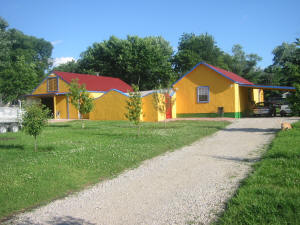
Home Sweet Home |
|
Here are the reasons you should move to the ghetto too: You can
be free and live free. You can be a part of society, not just your
strata of society. You can help those who need help and know the
difference. And you can lower your stress, your footprint, and your
consumption and do what every you want with the excess cash; like
build a big sailboat.
We live in a free country with the freedom to make our
own choices, yet most of us follow the crowd like sheep. Before we choose to live in a homeowners association, in a "good"
neighborhood, in one of the five model homes, furnished with the
same stuff from the same furniture stores and the same lawn and
garden stores and even use the same Christmas decorations. So
we are free to be free, but to me if you don't exercise that
freedom you are not free at all. Do you really need someone to tell
you what color your house should be?
We isolate people into these ghettos and then we ask
them to, "Just say no to drugs.", "Stay in school.", "Abstain from
sex.", "Don't have an abortion.", "Manage your money.", "Use credit
wisely.", "Build a strong family." We reach out by plastering
these messages on billboards and bus stop benches beside the sign
for "Payday Cash" and "Bail Bonds". What we don't do
is go live beside them. We deprive them of knowledge and
skills afforded to us by our educations and positions. And we
deprive them of our encouragement, our compassion and our respect.
And because we live in ignorance we deprive them of equality in how
we vote. When was the last time you visited a school in your cities
poverty district?
What hypocrites we were. We sit in church and pray for the poor
when it is those people we have shut out of our lives. They
can not live in our neighborhood. They don't go to school
with our children. They don't even shop in the same grocery
stores or attend the same church. The closest we come to them is
when they come to clean our office building or mow our lawn. Yet
these people for the most part are hard working, fun loving and love
their children. They offer to help at the drop of a hat and expect
nothing in return. These are some of the most courageous and tough
people I have ever met. My neighbor's wife at 18 years old
walked for 2 days across the Sonoran desert carrying her son. And
then there are other neighbors who give our ghetto its reputation.
We have crack whores, and bums, a good share of murders including
two children last year. To live in our society we must live among
our society, the good and the bad. That is what bonds us
together as a neighborhood. We know who to trust and we watch
each others back.
In the ghetto you can help those who need help and know the
difference. We use to occasionally volunteer for Habitat for
Humanity. Now we provide telephone access, internet access, tutor
English, translate school documents, make micro loans, advocate for
better schools, provide heaters when the power is out, climb trees
to cut limbs, and occasionally unclog sewer lines. We know the
people we help because they are our neighbors and we in turn we have
a better relationship with our neighbors than we ever had in a
homeowners association.
Cheap, Oh my God is it cheap to live in the ghetto. We paid
$1,500 USD for a lot that is 100 feet by 210 feet with the remnants
of an abandoned house. $30,000 later we have a 640 square foot
house, a 700 square foot shop and apartment, a 1200 square foot
private court yard, and a front yard with a 30 by 70 foot rock pad
and two 20 foot high, 30 foot span gantry cranes. And its only
4.5 miles from my downtown office. Try doing that in a bedroom
community.
Finally; don't be scared. Take some precautions; a fence,
some cameras, some warning signs, a couple of hand guns and a 12
gauge shotgun will get you started. After that you'll get to
know which neighbors you can trust and build that trust. Soon
you will be wondering what all the fuss was about and living free.
Clearing the Land
God brought us out of darkness and into a new land.
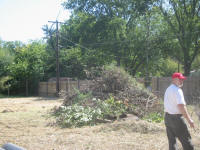
And in the new land God had
brought forth much brush.
And he did say "Clear it!"
"And cut the grass." |
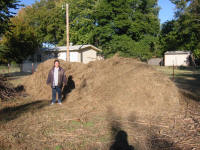
So the people toiled for 40
days and 40 nights to clear
the brush and cut the grass.
|

And when the work was done
God brought forth a dump
and
gave it to the people.
|
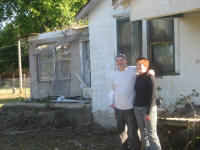
There was grumbling among
the people when they saw the
house God had given them.
|

For the people looked into
the house and saw no seat for
them to rest on.
|
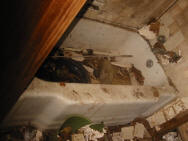
And they saw no place to
wash they bodies.
|

God was not pleased with the
grumbling and he did
smite the
wicked with poison ivy.
|
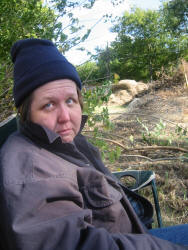
And there was much sorrow in
the land. |
|
Tear it Down! No Wait..
We decided to just teardown the shack and start fresh. So like
an upstanding citizen I went down to the City of Tulsa office for a
demolition permit. I thought it was funny that I needed buy a permit
to do what the elements and neglect had already been doing for 15
years, but my humor was lost on the city clerk. Then I was informed
that I would have to have a licensed plumber cap the sewer line, and
that would have to be inspected by a city inspector before I could
be given a permit. I could find nothing humorous is the stupidity of
that request. Things like that make you wonder if the city really
wants the ghetto to improve or if keeping it a ghetto is what best
serves the business men, builders, and real-estate developers that
control the city government.
So I studied the city ordnances a bit and discovered that I could
"remodel" and I would only need an inspection for the electrical in
order to have the electric meter set. So in order to dodge the
city inspector Nazis we decided to "remodel" the portion of the house
that was still standing. This seriously blurred the line between
"remodeling" and "building".
Building the Shack into a House
|